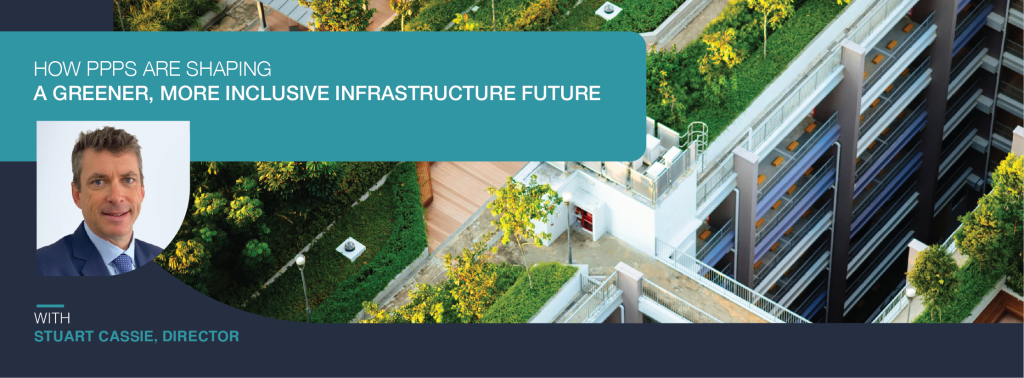Public-Private Partnerships (PPPs) are a powerful model of collaboration between public institutions and private companies, facilitating the rapid development of critical public infrastructure and services.
These agreements have been in existence for thousands of years, with early forms of PPPs used as legal instruments for infrastructure development and service provision under the Roman legions. This demonstrates the long-standing recognition of the benefits that can be achieved through collaborative efforts between the public and private sectors in delivering public services.
In recent times, while the specific arrangements, and scale of these partnerships have changed, the underlying principle of utilising private sector efficiencies and resources for public benefit has remained consistent. What has changed, is how PPPs are increasingly being held accountable to social and environmental standards.
With contemporary challenges like the energy transition and the housing crisis, modern PPPs have widened their scope and increased their impact, highlighting their growing relevance in providing solutions to these critical issues.
Below, TBH Director, Stuart Cassie (Strategic Advisory Services) provides an overview of the transforming role of Public-Private Partnerships and how they can be used to promote sustainable infrastructure development:
The Power of Collaboration
PPPs can be advantageous to both the public and private sectors.
The public sector can benefit from faster project timelines, technical expertise and budget predictability, while private companies can benefit from investing in projects offering a reasonable rate of return, compensated over the duration of the project.
Commonly used PPP structures include Build-Operate-Transfer (BOT) concessions, Design-Build-Finance-Operate (DBFO), and asset leasing models, enabling tailored risk-sharing partnerships. Having such diverse PPP structures allows governments and private companies to customise risk allocation, financing, and responsibilities to fit the specific needs and constraints of every infrastructure project, ultimately improving public services at a lower cost.
Given the significant investments governments need to make around infrastructure to meet today’s energy transition and housing crisis challenges, PPPs will become increasingly relevant, allowing the public sector to tap into alternative sources of capital off-balance sheet without increasing debt.
Sectors like renewable energy and housing, with well-established revenue models and known demand, are particularly attractive right now to the private sector. These segments not only offer financial returns but also align with broader goals of sustainability and social impact, making them particularly attractive for forward-thinking investors.
A new generation of PPPs
In recent years, PPPs have shifted from a focus on sharing risks between the public and private sectors to a more integrated approach aligned with Sustainable Development Goals (SDGs). Modern PPPs now focus not only on financial and operational efficiencies but also on social and environmental outcomes. These PPPs are often bound by contractual obligations that adhere to the social and environmental benchmarks set by the 2030 Agenda for Sustainable Development designed to prioritise the welfare of communities and the environment, ensuring that profitability does not come at the expense of ethical considerations.
From purely financial arrangements to agreements that can incorporate broader development goals such as those highlighted in the Addis Ababa Action Agenda, this new generation of PPPs aims to be more accountable, resilient, and focused on efficiency and accessibility.
The World Bank now provides guidance on integrating climate change considerations into PPP contracts. This includes specifying design features to reduce greenhouse gas emissions and requiring that private partners not only construct but also envision infrastructure that is designed for tomorrow’s economy.
Many government agencies now require these sustainability benchmarks to be met for any new infrastructure project undertaken with private partners. These benchmarks often include targets related to resource efficiency, waste management, and the conservation of natural habitats. Proposals are consequently assessed not only on traditional; criteria but also on their environmental impact and contribution to sustainability goals, with innovative efforts awarded additional points during the bid evaluation process.
Enhancing Sustainable Development through PPPs:
PPPs enable governments to undertake ambitious development projects with minimal public expenditure. By sharing the risks with private partners, governments can benefit from private sector expertise and capital to bridge gaps in public sector capacity and funding.
A critical element of this collaboration is the careful analysis, quantification, and scenario planning of potential risks, ensuring that they are managed effectively and economically by the parties best equipped to do so.
The integration of private and public financing can enable faster development of essential infrastructure and services, particularly those that align with sustainable development imperatives such as renewable energy and water system resilience. In developing countries, international development banks such as the World Bank, the International Monetary Fund (IMF), the Asian Development Bank (ADB), and the African Development Bank (AfDB) have been at the forefront of supporting these efforts, empowering officials in developing nations to negotiate PPP contracts that serve their country’s interests and advance SDGs.
Integrating Green Technologies
Green tech integration can help enhance resilience to climate change impacts like floods, heat waves and water stress that endanger long-term functionality of infrastructure. PPPs offer a means to embed these technologies into infrastructure projects to enhancing infrastructure resilience.
For instance, PPP contracts might require net-zero energy designs, electric vehicle charging infrastructure, smart water reuse systems, and responsible materials selection – and private partners can pilot these solutions and improve sustainability performance – with the help of public incentives and oversight.
Environmental technologies also lower operating and maintenance expenses over utility infrastructure lifecycles by more balanced use of resources. This naturally leads to cost savings, since more timely maintenance – using environmental technologies – helps prevent major breakdowns and the associated costly repairs.
Legal and Risk Management Evolution
PPPs of the past often overlooked formalising legal frameworks and risk management – an oversight that repeatedly strained complex, long-term projects.
As climate change brings more frequent extreme weather events, new legal frameworks are being used to mandate climate resilience standards in infrastructure PPPs, and as a result, innovative approaches to risk sharing between public and private partners are emerging.
Many governments now require minimum climate adaptation measures in infrastructure PPP contracts like drainage upgrades, cooling systems, and backup power, and failure to meet these obligations can incur financial penalties for private partners. Additionally, contingency funds are now set aside specifically for climate-related repairs like storm damage. This provides contingency financing while shifting the onus of preparing infrastructure onto private partners.
Putting People First
PPPs can transform and improve the lives of economically and socially vulnerable people by incorporating more inclusive growth and community participation into projects to enhance development gains and sustainability.
For this reason, partners are now under greater contractual obligation to focus on long-term, sustainable, and systemic impact by engaging stakeholders, generating jobs, building related services, and investing in adjacent community infrastructure.
To bring together multiple stakeholders, engaging with the community at the outset is crucial. This involves not just informing the public about the project but actively seeking their input and feedback. Community engagement should be seen as a two-way process where the community’s needs and concerns are genuinely considered in the project design.
Using the technical expertise, approaches, and networks of both government agencies and private-sector organisations, PPPs are able to create unique approaches to address challenges traditionally encountered by government resources and competing priorities. For example, PPPs frequently make commitments to employ local staff for a specified percentage of jobs, or to upskill workers for roles in infrastructure operation after project completion. This approach not only makes use of local insights for better project design but also contributes to the local economy by providing employment opportunities and enhancing the skill set of the community.
Emerging Trends in PPPs
As PPPs continue to evolve, several emerging trends are shaping their future. These trends reflect the changing landscape of global development, the growing emphasis on sustainability, and the need for innovation in financing and project delivery:
Innovative Hybrid PPP Models
Hybrid PPPs provide greater flexibility than conventional concessions or management contracts. By combining features from different PPP structures, hybrid frameworks are able to offer more adaptable solutions for complex, multi-layered projects.
Phased and Progressive PPPs
Rather than awarding contracts upfront, progressive procurement enables informed decision-making at each project stage, facilitating necessary adjustments based on evolving progress, risk factors and market variables. This data-driven trend uses emerging digital tools and advanced analytics to optimise real-time PPP performance while managing uncertainties. Continuous data gathering and assessment also helps provide increased transparency for public stakeholders.
Adaptive Models for Developing World Contexts
Historically, public-private partnership frameworks and best practices have been driven by Western nations. However, it has repeatedly proven difficult to directly replicate these governance models in emerging economies because the legal systems, institutional capacities, political uncertainties, social needs, and project environments of developing nations are significantly different. This occurred not long ago in Ghana, a country that struggled to implement various PPP initiatives, from affordable housing to food production due to a lack of adaptation to the local context.
Each country’s unique circumstances should always be considered to create effective partnerships, since when adaptive models for PPP structures and processes are tailored to developing nations’ needs and constraints, the public and private sectors can better collaborate to overcome challenges and accomplish goals.
Moving Forward
In the coming years, PPP agreements will continue to develop to meet the needs of end users by combining the strengths of both the public and private sectors to achieve common goals.
Circular economy principles will likely become more prevalent in PPPs, with contracts establishing clear objectives, criteria, and incentives for waste management. This may include setting targets for the reduction of construction and demolition waste, incorporating requirements for the use of recycled materials, and designing infrastructure that can be easily adapted or dismantled for reuse in other projects.
The collaborative approach of PPPs will help overcome some of the financial and technical challenges associated with large scale renewable energy projects, especially in environments where the risks and costs associated with these projects are significant.
Lastly, with technology more advanced and complicated than ever, by tapping into the private sector’s technical resources and know-how, PPPs will facilitate the adoption of digital solutions within public institutions, contributing to economic growth and improving the quality of services provided to the public.
TBH: Helping to Plan for the Future
For thousands of years societies around the world have recognised the benefits of public-private collaborations for the common good. By making use of the strengths of both sectors, PPPs are not only addressing contemporary challenges such as the energy transition and housing crisis but are also setting a new standard for responsible and sustainable development, providing benefits including faster project delivery, enhanced cost-effectiveness, improved infrastructure quality, and community engagement.
To help integrate infrastructure projects that benefit the public with the needs of the private sector, TBH is proud to have been involved in several well-known Australian PPP projects, including the Capital Metro Light Rail and the Sydney CBD and Southeast Light Rail. Our first-hand experience helping clients bid on PPPs in the road, rail, energy, and health sectors means we have a deep understanding of, and the ability to solve, many of the challenges clients and the industry face, ensuring compliance and protecting the interests of all parties.
About Stuart Cassie, Director

Director Stuart Cassie (Strategic Advisory Services) is passionate about assisting clients in comprehending the issues and obstacles they face and aiding them in discovering creative, innovative, and sustainable solutions to those challenges.

